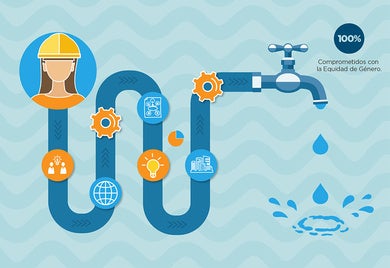
Three best practices for energy companies investing in women
Three years ago, Marie-José Nadeau took the helm as the first woman to chair the World Energy Congress in its 90-year-history. She cautioned that the energy business was at a critical stage, suffering from underperformance and facing disruptive change. In her view, the industry would not have the ability to innovate and tackle these challenges without gender diversity. At the time, only 4% of executive board members at the top 100 utilities companies were women. Today, this number has inched up by only 1%, according to EY’s 2016 Women in Power and Utilities Index. At this rate, it would take the power industry four decades to reach 30% of women participation in boards. [clickToTweet tweet="At this rate, it would take the power industry 4 decades to reach 30% of women participation in boards" quote="At this rate, it would take the power industry four decades to reach 30% of women participation in boards" theme="style1"] At the employee level, a handful of energy companies in Latin America and the Caribbean are starting to invest in recruiting and training female personnel in non-traditional roles, for example, installing solar panels in remote areas and changing LED public lighting in cities. As renewable energy scales up across the region, technical jobs in solar and wind will be in high demand. Energy companies will have to widen their talent pool to meet this need. Here are three ways energy companies are already investing in opportunities that benefit men and women: 1. Investing in gender certifications Gender certifications today are what LEED certifications were a decade ago —a third-party seal of approval for sustainability— and some companies in Latin America are already investing in them. Based in Switzerland, global certifier EDGE (Economic Dividends for Gender Equality) is increasing its presence in Latin America and the Caribbean. Another option is seeking certification at the country level. These type of gender certifications allows companies to map and benchmark their efforts to create, support and advance gender equality throughout the workplace. In Mexico, this was the route that an energy service company took to start transforming its corporate culture. Based in Monterrey, Óptima Energía works with cities to replace incandescent street lights with energy-efficient LED street lamps. Two years ago, Óptima Energía embarked on a gender certification program through the Mexican Standards for Labor Equality and Non-Discrimination. Investing in a gender certification is just one of many steps this company is taking to ensure an equitable and inclusive workplace that attracts the best employees. 2. Partnering with technical universities to train new talent The solar industry is growing exponentially in Latin America and the Caribbean, and demand for experienced solar technicians is outstripping supply of qualified people. The same is true for the wind sector. With nearly two million people employed in renewable energy jobs, the need for a steady pipeline of qualified talent is opening doors for women. In the last five years, Uruguay has become a powerhouse wind producer, steadily moving away from relying on fossil fuels and hydropower. Solar is now ramping up. In 2015, the energy companies Technova and Sky Solar started installing solar panels in Paysandú, a small city in Western Uruguay on the Argentinian border. The companies wanted to hire locally, and partnered with Universidad del Trabajo (UTU) and Instituto Nacional de Empleos y Formación Profesional (INEFOP) to train local personnel in the assembly of solar photovoltaic projects. They set a target of 40% female participation in their programs and met their goal. 3. Recruiting women in STEM fields In Latin America, 45% of scientific researchers are women, surpassing even the global average; yet, women are vastly under-represented in science, technology, engineering and mathematics (STEM) fields. Cultural and socioeconomic barriers often lead young women to drop out of school to meet traditional obligations like care giving. In Panama, Grupo Ecos invested in an internship program targeting female students on STEM and finance tracks for the Divisa Solar project, the first utility-scale solar park in the country. Financed by IDB Invest (formerly known as Inter-American Investment Corporation) and the Canadian Climate Fund for the Private Sector in the Americas (C2F), Divisa Solar is changing the conversation around traditional gender roles while benefitting local women professionals. Empowering women makes business sense The evidence is clear —greater gender diversity drives business success. As the renewable energy boom in Latin America leaps ahead, investing in opportunities for women professionals will be critical for energy companies to stay ahead of the curve. Alison Kay, EY global vice-chair of industry, put it in these terms: “In these times of disruptive change, as the sector undergoes fundamental transformation, diverse leadership teams make good business sense.” Subscribe to receive more content like this! [mc4wp_form]

Can banks serve the Women’s Market without sidelining men?
If a bank makes targeted efforts to better serve women customers, does this necessarily mean men are shortchanged? Global experts at the recent Global Banking Alliance for Women (GBA) All-Stars Academy in the Dominican Republic agreed with a resounding “no”.

International Women’s Day: more than a day for women and men
Going beyond the day itself, International Women’s Day is an opportunity for all to commit to advancing gender equality and create real workplace inclusion. I challenge you to go one step further and make gender equality everyone’s business.

Untapped Potential: Water, Women and Public-Private Partnerships
More than half century ago, John F. Kennedy said: “Anyone who can solve the problems of water will be worthy of two Nobel prizes — one for peace and one for science.” Today, despite having a third of the world’s freshwater resources, Latin America and the Caribbean is home to 30 million people without access to clean drinking water, and 100 million without safe sanitation. The impressive urban growth in the region during recent years has only exacerbated this problem. Women provide a unique perspective for water management The water availability challenge is already evident in the region — particularly within the poor communities in cities. Women and girls are the most affected in these households, as they are usually in charge of ensuring water provision for their families. For this reason, women can play a key role in the implementation of innovative solutions that are in-tune with the needs and preferences of impoverished communities. This can have a positive impact not only in less favored urban areas, but also in the overall way in which the sector currently operates. There are already cases where women have taken the lead in the management of poor communities’ water systems, and the results have been encouraging. This user-centered approach acknowledges women’s vital role in water provision, and is helpful not only in refining project design and management, but can also increase consumers’ willingness to pay for the service. For utility providers, this can translate into multiple benefits, including improved cash flows, more resources for infrastructure investments, and service quality enhancements. [clickToTweet tweet="Women make up less than 17% of the water and sanitation labor force #NegociosSostenibles" quote="Women make up less than 17% of the water and sanitation labor force" theme="style1"] Women’s participation in the sector does not only bring financial advantages. A Deloitte study shows that when men and women are equally involved in the design and operation of water systems, significant improvements in governance, transparency and sustainability are achieved. For example, in more than 120 water projects that included the participation of women during the design phase, the effectiveness was six to seven times higher than in projects which only included men. Yet, today women make up less than 17% of the water and sanitation labor force, and only a small fraction of management and technical experts. More needs to be done to reduce the gender gap in water provision services, and to ensure that more women have access to key roles — such as engineers, system designers and utility managers. Forging new partnerships in water One way to reduce this gender gap is by identifying partners that can catalyze the financial, technical and social advantages that the participation of women in water projects can bring – and the private sector is particularly well suited for the task. Additionally, promoting private investments in the sector can help tackle another important gap: the investment one. In 2012, only 0.2% of the region’s gross domestic product (GDP) was invested in water and sanitation, compared to 3% in overall infrastructure. Public-private partnerships (PPPs) have traditionally provided much-needed financing, technical know-how transfer and best practices in infrastructure management. While adopting PPP schemes is commonplace in energy and transportation projects, this has not been the case for water. In 2016, out of 96 PPP projects that reached financial closure in Latin America and the Caribbean, only seven were related to water and sanitation. Currently, the region’s public sector continues to hold the lion’s share of water and sanitation services. Nevertheless, many cities have adopted PPP models that work. Cartagena and Bogota contract services to mixed companies, jointly owned by local authorities, a private operator, and local private shareholders. The results have been impressive: between 1994 and 2002, access to clean water and sanitation improved significantly, and more than 80% of new connections were in poor neighborhoods. [clickToTweet tweet="Only 7 out of 96 PPP projects in #Latam and #Caribbean were for water and sanitation in 2016" quote="Only 7 out of 96 PPP projects in Latin America and the Caribbean were for water and sanitation in 2016" theme="style1"] Earlier this year, the Inter-American Development Bank (IDB) Group partnered with the Korean government and the Korea Eximbank to bring best practices in water management technology to Colombia. As part of a knowledge-sharing program, companies from both countries met in Bogota to better understand the operating conditions in that city and to discuss technology transfer plans. Among the conclusions of the meetings, both parts acknowledged the role that the private sector had in improving Bogota´s water operations. As urban demand for water rises across the region, leveraging the untapped potential of both public-private partnerships and women’s participation in water projects will be invaluable. Facilitating access to PPP solutions is one way to do it, like the new single window for PPPs launched earlier this year by the IDB Group. Another way is to have gender-inclusive perspectives at the core of the projects with women playing an active role in the development and implementation of sustainable projects, which is one of our commitments. By implementing this approach, our goal to promote solutions that effectively tackle the region’s water challenges. Subscribe to receive more content like this! [mc4wp_form]

Empower women and investors will follow
Gender equality is no longer a choice for companies. It is not only about fairness, but about business success. For investors, this has become so clear that one of the world’s largest asset managers has just placed a statue of a defiant girl in front of Wall Street’s iconic bull in New York City to remind businesses that the time to fight for gender equality is now. Why? Because investors have realized that companies that foster diversity yield higher returns. More diversity improves decision-making, reputation, productivity, and employee retention and satisfaction, whTry ich in turn leads to higher returns. Companies with more diverse workforces are also better equipped to innovate in product development, tapping into new business opportunities, such as the women’s market. Investors are looking for results on gender equality But how can companies take concrete actions in line with what investors expect? The answer is not easy, as it requires looking at your company through a completely different lens. Statements and mere commitments to gender equality are not enough. In today’s data-driven world, investors are looking for information to evaluate companies’ performance and their environmental and social footprint. In the past few years, several gender equality indexes have emerged to help investors make informed decisions. Examples include the Barclays Women in Leadership Total Return Index, Pax Ellevate Global Women’s Leadership Index and the Bloomberg’s Financial Services Gender-Equality Index, among others. These benchmarks are tracking gender outcomes, including equal compensation and the number of women in leadership positions, employee policies, ability to create products and services for women, and community engagement. Some of these indexes have investment products to capture the benefits of gender diversity. Since 2014, both Barclays’ Women in Leadership Exchange Trade Notes and Pax Ellevate’s Global Women’s Index Fund enable investors to allocate capital in companies with strong female leadership. As investors’ appetite grow, similar initiatives are under way. Last year SSGA and California State Teachers Retirement System, the second-largest public pension fund in the US, launched the SPDR SSGA Gender Diversity Index ETF (SHE) to invest in companies with high levels of diversity on their boards. With over $280 million in assets, Berkshire Hathaway Inc and Oracle Corp. are among its top investors. A free tool to evaluate gender equality For those willing to roll up their sleeves and move beyond good intentions, the first step is knowing where you are and what you are doing. With this goal in mind, IDB Invest (formerly known as Inter-American Investment Corporation) and the Multilateral Investment Fund, along with UN Global Compact, UN Women and other public and private partners, have created a tool to help companies assess their gender equality performance. The tool follows the UN Women’s Empowerment Principles (WEPs) to unleash the potential of women in the workplace, marketplace and the community. The assessment is free and confidential and can be done by any company from any sector in any country. It looks at corporate policies in place and evaluates the extent to which firms provide equal opportunities, adequate work life balance, support to gender equality in the supply chain and respect to women’s rights in local communities. The tool has far-reaching potential for companies. Designed with the feedback of nearly 200 companies worldwide, the tool has proven to be eye opening for the firms that participated in the pilot phase. Some found that the assessment made them rethink their approach to gender equality in procurement and marketing, while others said it compelled senior management to improve processes. Others highlighted that the tool provided a road map to better integrate gender initiatives into the broader company’s strategy. So, if you are ready to face the bull and reap the benefits, complete the assessment and take action. Investors are waiting. This article was originally published on The Huffington Post Subscribe to receive more content like this! [mc4wp_form]

Three ways banks can attract more women customers
Narrowing the global gender gap could add $12 trillion in annual global gross domestic product by 2025. In Latin America and the Caribbean, access to finance for women-led companies is a key driver of this gap. Two out of five small and medium-sized businesses in the region are owned or managed by women, yet 70% of them still have unserved or underserved credit needs. Despite this discrepancy, there is an overwhelming sense of optimism: more than two thirds of active, early-stage women entrepreneurs are opening businesses because they see clear opportunities, not out of necessity.